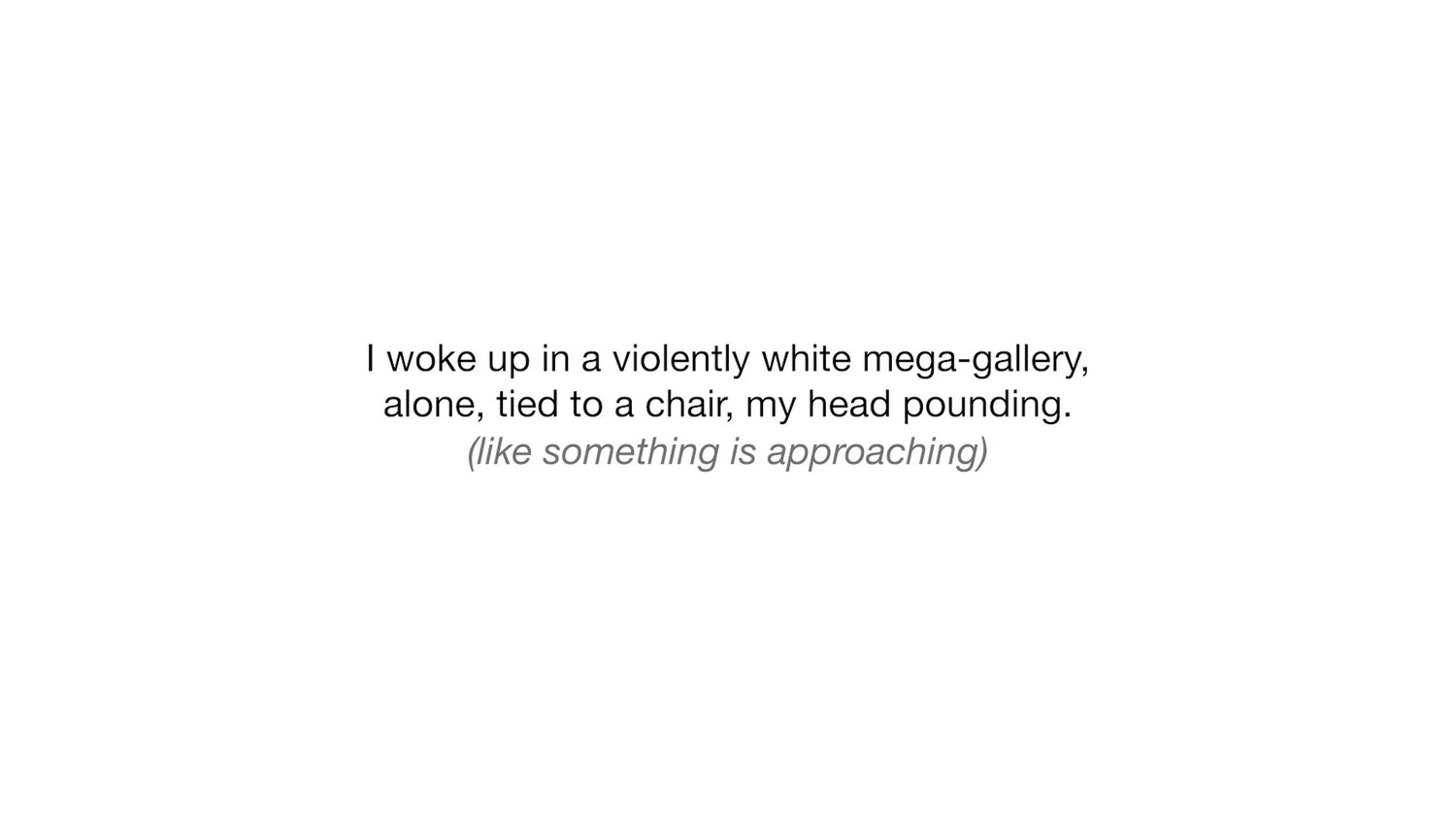A horny, sadomasochistic Philanthropist approaches an underpaid nonprofit Gallery Worker. The gallery has recently gained its 501(c)(3) status, and in just a few days its bargaining unit will vote to unionize. She, the Philanthropist, introduces herself as “a patron of the arts,” and he, the Gallery Worker, dubs her a war profiteer for earning her fortune in defense contracting. They say these things with a wink and a smile. “I’ll let you in on a little secret,” she says. “Nonprofits make me very horny.”
There are no literal winks and smiles in Mission Drift (2023), an experimental video essay by artist-educator Charles de Agustin, as there are no “images” in the film at all. For all thirteen minutes the background is white with a standard black typeface. The Gallery Worker vocalizes the text—what de Agustin calls “narrativized research as spoken prose”—with slight tonal shifts indicating who is speaking. The tale he tells is at once confessional and cautionary: a condensed history of U.S. federal funding for the arts with playful didacticism, time-bending corporate co-optation, and of course, the film’s central seduction.
As their physical relationship escalates, the Philanthropist and the Gallery Worker role-play forces beyond just themselves. The invisible hand of capital accumulation, criminalized poverty, white saviorism, “art as activism,” political nihilism, and workplace exploitation maneuvers its way into their ego-strokes, chokes, and trances. The deeper the philanthropist “infiltrates,” the more legibility runs counter to de Agustin’s goals; staggering nuance emerges from his black-and-white formal bounds.
The Philanthropist transports the Gallery Worker to a timeline in which the gallery has rejected “blood money,” i.e., is gutted to its metal beams with no art in sight. The Gallery Worker berates the Philanthropist with a history of the Comprehensive Training and Employment Act (CETA), a bill signed by Nixon in response to widespread unemployment in the early 1970s. CETA employed hundreds of thousands of workers across the public-service sector, including 20,000 visual, performing, and literary artists and arts administrators. New York City’s CETA Artists Project was one of the largest and most desirable nationwide, as participants received decent salaries, benefits, and studio time in exchange for leading workshops, developing installations, and putting on public shows. Carter re-signed the bill in 1977 but, alongside a slew of other Great Society vestige programs, it was repealed when Reagan took office in 1981.
Reagan’s $22 billion attack on welfare, combined with increased military spending, consigned millions to poverty and laid the foundation for the sprawling, insidious nonprofit nexus we see today. In the absence of social services, “social change” organizations rose to fill the void.
Often referred to as the “third sector,” nonprofits occupy the strange, strategic middle ground of public/private interests. Some are contracted by government agencies directly, all are exempt from tax liabilities and provide donor write-offs, and most are funded by corporate or family-operated foundations that support their mission. Nonprofits compete for funding of this nature and then implement projects that align with the grantor’s “giving priorities.” Here, liberal philanthropists signal their do-goodism while, through tax benefits, reproduce inequality by diminishing their financial contribution to society at large. If this were not the case, philanthropists wouldn’t make tax-deductible donations but join in the struggle toward their own obsolescence.
This history lesson continues uninterrupted for several minutes. The Gallery Worker concedes that, yes, great art can get made with transformative aspirations but “we should be wary of the aestheticization of what desperately needs to be advanced as robust organizing and policy,” lest we applaud the art product as a radical end in itself.
Suddenly, the Gallery Worker begins to choke. Are these the Philanthropist’s hands around his neck? And, if so, in an act of harm or mutual desire? Could the 501(c)(3) itself be punishing the Gallery Worker for uttering these truths and warnings? Or perhaps this is de Agustin’s doing, swooping in and suffocating his narrator with his own artistic impulses and anticapitalist convictions. It’s asphyxiating, isn’t it? Making art that is at once cynical and bright-eyed in its political aspirations.
All this pain, power, humiliation, love, cynicism, hope, subordination, and insubordination burst in Mission Drift’s climactic scene. Words like care and collectivity—whose meanings could be balms to the ravages of exploitation—are co-opted, commodified, hollowed, and spit back out.
“No difference between caring and cumming. ‘Prioritizing the politics of cum’—you should add that to your mission statement,” the Gallery Worker sneers.
“You gave me the best orgasms of my life this week. In return, I'll guarantee you a very comfortable career. Just promise me you’ll stop spewing all this nonsense.”
Dialogue blurs, on-screen text quickens, synth music slides upward and downward at the same time. The film’s baked-in open captions and audio descriptions become increasingly abstract in meaning and appearance. The screen is blindingly, relentlessly white. Will the Gallery Worker agree to this devilish deal? Hasn’t he already?
Mission Drift screens tonight, July 20, at Maysles Documentary Center, followed by a discussion with the filmmaker, Charles de Agustin.
This is an excerpt of a longer piece about Mission Drift and the nonprofit industrial complex, to be published later this year.



